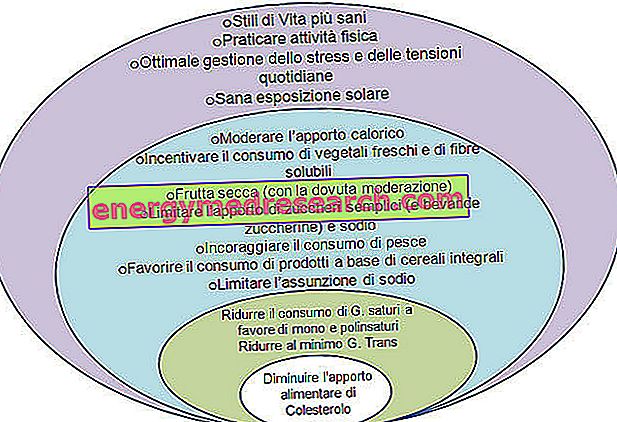Generality
Epigastric pain is a painful sensation that occurs in the upper-middle region of the abdomen. The cause of this may be numerous conditions, some even very serious, such as pancreatic cancer, stomach cancer or myocardial infarction.

The associated symptoms depend on what sustains the appearance of pain: for example, patients with epigastric pain due to myocardial infarction could complain of a painful sensation spread to the shoulder and / or arm, dyspnea, wheezing during breathing, etc.
A correct diagnosis of the causes that cause epigastric pain is essential for planning the most appropriate therapy.
What is epigastric pain?
Epigastric pain is that painful sensation that is located in the epigastrium .
In anatomical language, the term epigastrium (or epigastric region ) identifies the highest and central area of the abdomen, bounded above by the costal cartilages and inferiorly by the umbilical region.
ANATOMY OF THE EPIGASTRIO
The epigastrium represents one of the nine anatomical regions with which the doctors describe the abdomen of the human being. Proceeding from left to right and from top to bottom, the other eight sections are: right hypochondrium, left hypochondrium, right lumbar region, umbilical region, left lumbar region, right iliac fossa, hypogastrium and left iliac fossa.
The epigastrium is located between the right hypochondrium and the left hypochondrium.

Below the epigastric region, there are several internal organs, including:
- The pylorus. It is the terminal part of the stomach, in charge of regulating the entry of the gastric contents into the small intestine (ie the first part of the intestine). A valve, known as the pyloric sphincter, ensures an accurate passage of food between the stomach and intestines.
- The duodenum. It is the first part of the small intestine; the latter also includes fasting and ileum.
- Pancreas
- Part of the liver
- Part of the aorta
- Part of the inferior vena cava
- Transverse colon. It is the third section of the large intestine (or large intestine); it follows the cecum and the ascending colon, while it precedes the descending colon, the sigma and the rectum. The transverse colon is also the highest part of the large intestine.
Causes
To learn more: Epigastralgia - Causes and Symptoms
Epigastric pain is a symptom, therefore the consequence of a certain behavior or of a specific morbid condition.
In most cases, it can be caused by:
- An excessive meal . This can lead to poor digestion (or dyspepsia).
- Drink alcoholic beverages while you dine .
- Consume large quantities of fatty or spicy foods .
- Gastroesophageal reflux disease . It consists in the excessive and chronic ascent, towards the esophagus, of the acid content of the stomach (gastric juices). The esophagus is the channel that connects the mouth to the stomach; the frequent presence, inside, of acid substances coming from the stomach inflames the mucous walls and, subsequently, determines the attrition.
- The presence of gastritis . It is the inflammation of the gastric wall, that is of the inner wall of the stomach.
- A form of lactose intolerance . Lactose is the sugar found in milk and its derivatives. Lactose intolerance is a condition in which the consumption of milk and its derivatives causes a non-allergic reaction, characterized by gastrointestinal disorders such as bloating, cramps and diarrhea.
- The state of pregnancy . In pregnant women, the appearance of epigastric pain can be due to two reasons: a slowing down of the digestive process, induced by the hormonal variations that characterize the gestation, or an increased pressure at the abdominal level by the growing fetus.
- Intake of some gastrolesive drugs, such as so-called non-steroidal anti-inflammatory drugs (NSAIDs) . Aspirin is an NSAID which, among its side effects, also presents epigastric pain.
CAUSES LESS COMMON OF EPIGASTRIC PAIN
Although more rarely, epigastric pain may arise due to:
- Barrett's Esophagus . In those affected, a particular process is triggered which causes the replacement of the normal lining of the esophagus with a tissue very similar to the one that covers the duodenum. Barrett's esophagus predisposes to cancer of the esophagus (or esophageal tumor).
- Calculations in the biliary tract (or gallbladder stones) . They are "pebbles" that form inside the gallbladder (or gall bladder), a saccular organ located under the liver and used to contain bile. The formation of calculi in the biliary tract is due to the precipitation of the substances that make up bile (in particular, cholesterol and bile pigments).
Bile is a substance produced by the liver, which serves for digestion and fat absorption.
- Hiatal hernia . The hiatal hernia is the protrusion of the stomach through the so-called esophageal diaphragmatic hiatus, that is the hole of the diaphragm in which the esophagus normally enters.
According to a recent statistic, hiatal hernia would affect 15% of Italians.
- Pancreatic cancer . It is one of the malignant tumors with the worst prognosis. Unfortunately, the low presence of symptoms in the initial phase must be added to the high mortality rate, which greatly reduces the chances of an early diagnosis.
- Pancreatitis . It is the medical term that identifies the inflammation of the pancreas. There are forms of acute pancreatitis and forms of chronic pancreatitis.
- Peptic ulcer or perforated peptic ulcer . Peptic ulcers are small, well localized lesions that affect the mucosa of the digestive system exposed to the action of gastric juices. They can therefore have various locations: stomach (gastric ulcer), duodenum (duodenal ulcer) and lower part of the esophagus (esophageal ulcer).
Peptic ulcers are defined as perforated when the lesions that characterize them are very deep, so that there is an involvement of the blood vessels (hemorrhages).
- Stomach cancer . In 90% of cases, stomach cancer (or stomach cancer) originates from the mucosal cells that form the inner wall of the stomach and from the glands interposed between the aforementioned cells.
This malignant neoplasm generally affects men over the age of 55, who are smokers and have bad eating habits (smoked foods, little fruit and little vegetables).
- Esophagus cancer . Also known as esophageal cancer, it usually originates from the cells that line the inner surface of the esophageal duct. It is a very aggressive malignant neoplasm.
EPIGASTRIC PAIN OF CARDIAC NATURE
With roughly the same frequency as in previous cases, epigastric pain may be related to cardiac problems, in particular angina pectoris and myocardial infarction (or heart attack ).
What are angina pectoris and myocardial infarction?
Angina pectoris is a syndrome characterized mainly by oppressive and constrictive pain in the center of the chest. Its appearance is the result of a reduction in the blood supply to the heart, compared to what is necessary for its complete functionality. Generally, the reduced blood flow to the myocardium (ie the heart muscle) is due to a process of atherosclerosis that affects the coronary arteries.
Angina pectoris is a condition that typically occurs under stress, when, in the face of an increased demand for blood from the heart, there is no adequate response in terms of perfusion.
The heart attack, on the other hand, is a much more serious condition than angina pectoris. In those suffering from a myocardial infarction, the blood supply to the heart is reduced to the point that a more or less extended portion of cardiac muscle undergoes necrosis (that is to death). Moreover, without the right blood supply, there is a lack of oxygen and nutrients, essential elements for the survival of any cell in the body.
Symptoms
Other symptoms may be associated with epigastric pain. These manifestations depend on the underlying morbid condition, that is the cause that triggered the painful sensation.
Since pain in the epigastric region generally reflects the presence of a gastrointestinal problem, the most common associated symptoms are:
- Pain also in the rest of the abdomen
- Swelling or abdominal distention
- Sense of vomit
- Nausea with vomiting or without vomiting
- Burning in the stomach and the upper part of the chest
- Constipation
- Diarrhea
- Flatulence
- Real pain in the upper part of the chest
WHEN PAIN IS ASSOCIATED WITH HEART PROBLEMS
When epigastric pain is related to heart problems, such as angina pectoris or myocardial infarction, the symptoms that may accompany its presence are:
- Constrictive and oppressive chest pain
- Palpitations
- Widespread pain also in the shoulder and left arm
- Respiratory problems, including dyspnea (shortness of breath), difficulty breathing, wheezing during breathing and feeling of suffocation
- I vomit with blood or a black substance, like coffee grounds
COMPLICATIONS
Epigastric pain per se is not the cause of a specific complication, but rather the causes that caused its appearance.
For example, in the case of stomach cancer, a possible complication of this pathology is the spread of cancer cells in adjacent organs and metastasization (ie the process by which neoplastic cells spread to other parts of the body, through the bloodstream).
Even when it is not associated with particularly serious diseases, persistent epigastric pain can be very annoying and affect the standard of living of those affected.
WHEN TO REFER TO THE DOCTOR?
It is good to consult a doctor, or go to the nearest hospital, if the epigastric pain is persistent, annoying and / or associated with symptoms that can lead to some serious morbid condition.
Symptoms and signs in which an immediate medical consultation is recommended.
- Painful constrictive-oppressive type, which spreads from the epigastrium to the whole chest, shoulder and arm.
- Nausea with vomiting.
- Vomit with blood or substance of black color.
- Respiratory problems.
Diagnosis
To diagnose the condition that sustains epigastric pain, doctors first use a thorough physical examination . During this evaluation, in addition to visiting the patient, they question him about the characteristics of the symptomatology and his clinical history .
The most common questions - because they are more important in terms of information provided - are:
- When did epigastric pain appear? How long has the painful feeling been in place?
- Are there moments of the day when epigastric pain is particularly severe?
- Does the patient suffer from lactose intolerance?
- Does the patient suffer from heart problems, due to angina pectoris or myocardial infarction?
- Are there other symptoms or disorders, besides epigastric pain?
- Does the patient take any particular medicine?
- Where is the precise location of the pain?
Only after completing the physical examination, the doctor decides whether it is appropriate to proceed with more specific instrumental tests, such as for example gastroscopy, chest radiography, electrocardiogram, nuclear magnetic resonance, CT (Computerized Axial Tomography). ), blood tests, etc.
The most serious pathologies and potentially poor prognosis, which determine epigastric pain.
- Stomach cancer
- Esophagus cancer
- Pancreatic cancer
- Angina pectoris
- Myocardial infarction
Treatment
The therapeutic treatment foreseen in case of pain with epigastric site depends on the triggering causes. Therefore, it is clear how important a correct diagnosis of the underlying disease is.
In general, the invasiveness of the therapy is much higher, the more severe (or diagnosed late) the conditions leading to the appearance of epigastric pain.



